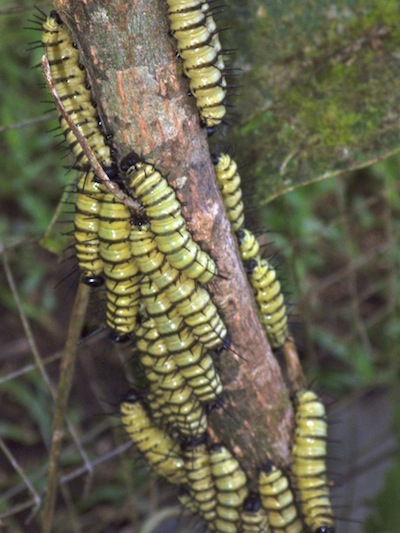H. doris is notable for having its hindwing color vary from red to green, blue and yellow. The forms appear to mimic different species with the red form mimicking the Papilionid Parides and the blue and yellow forms mimicking H. sara (see Table 6 for photos). It feeds as a specialist on large P. ambigua vines. One hundred or more eggs are laid in a large cluster on a new leaf, and larvae feed and pupate gregariously. A single clutch is capable of defoliating an entire P. ambigua plant. Although this species has been sometimes placed in the genus Laparus, genetic analysis nests it within group II lineage Heliconius. It is very much like a typical Heliconius in coloration and behavior, and like other Heliconius, feeds on pollen. Unlike most other group II Heliconius, it is obligately host specific and its larvae die when placed on host plants other than P. ambigua (and possibly close relatives such as P. nitida). Range: Mexico to the Amazon Basin.
Life cycle (in La Selva Ambient Laboratory): eggs take 4-5 days to hatch, turning reddish the day before hatching. Older eggs hatch first; more hatch the next day. Larvae are highly gregarious, older and younger larvae mix freely. Moult to 2nd instar on day 5. Larvae feed and rest synchronously, alternating 30-40 minute feeding bouts with 30-40 minute rest periods. Moult to 3rd instar on day 9; 4th on day 12 and 5th on day 14. Feeding bouts last about 80 minutes; rest bouts 60-75 minutes. Moult to 5th instar required 26h, starting 12 noon and finishing 14:00h next day. On day 23 larvae stop feeding and start moving in a line but will not leave plant (or glass jar holding plant!). Small younger larvae will join line but stop to feed. On day 25 pupated in early evening (pupation times: 17:57, 18:54, 19:43, 21:18, all d25; 18:18 d26; 20:56 d27). Pupae purplish color, hanging together from hanging twig 5mm diameter. Pupae eclose 10 am on day 33, after 8 days in pupa (eclosure times: 10:18 d23, 6:00 d24, 5:44 d25, 6:06 d26). Progeny all red morph. Release outside on P. ambigua plant. Slow growing as compared with H. cydno and other single-feeding species.
H. doris larvae actively feeding on host P. ambigua did not release any measureable amount of HCN gas, even after consumption of 2 full-sized leaves. Crushing these leaves mechanically would have released about 5 parts per million HCN in the closed 9.6 liter bell jar. The limit of detection for the meter was 0.3 ppm, so the percentage gas loss for those feeding larvae was less than 6%. A similar finding occurred with H. sara feeding on P. auriculata. Movies


